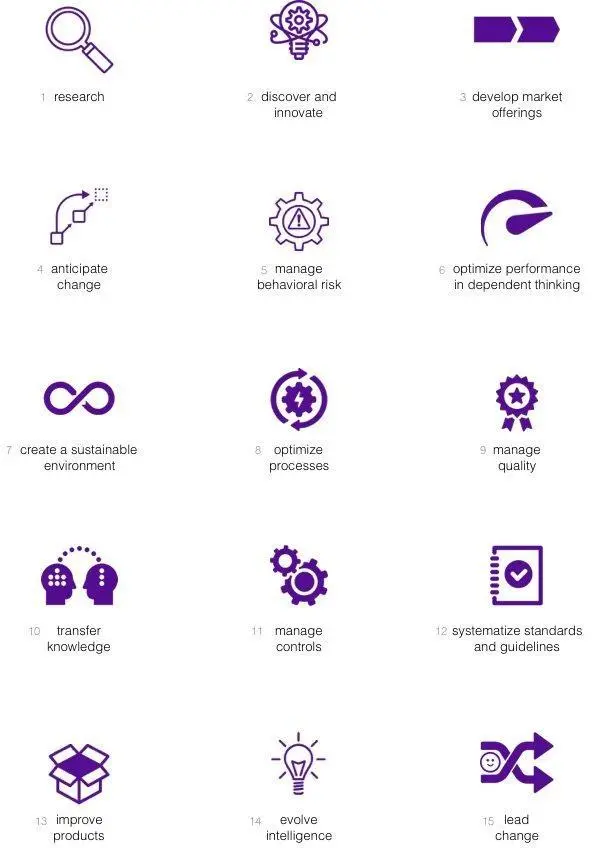Comments (2)
Jenna Ford
Excellent content !!
Rob Young
Insightful !

Improving cognitive performance is a strategic imperative for anticipatory leaders. Yet, cognitive performance slows down due to cognitive friction. Cognitive friction occurs when professionals can’t think through uncertainties clearly in their minds. These uncertainties include:
In an organization, cognitive friction occurs frequently across many professional roles, minds and perspectives. For the 15 areas in a cognitive operation below, cognitive friction not only spans many responsibilities, it also impacts relationships and shapes cultures.
There are 15 areas of a cognitive operation.
Cognitive friction occurs when two or more professionals are challenged to get on the same page. They must resolve their perspectives — which can be very challenging. In business, professionals:
Cognitive friction exists within the minds of professionals and creates undue stress. The six reasons friction occurs is due to:
 When processing multiple data points in the mind, cognitive work can become a highly stressful activity. It’s amazing how many leaders are not equipped with cognitive tools to manage uncertainty across situations, close their knowledge gaps and achieve expected results. When a situation includes more than seven variables, it’s well-known that the human mind is not able to process this level of complexity. Think how we receive, process and remember phone numbers. Our minds are not wired to synthesize 10 or more digits at a time. In the U.S., people think about the 10 digits in a pattern of a 3-digit area code, a 3-digit prefix and 4-digits for the line number; our minds consume, process and recall smaller chunks of information.
When processing multiple data points in the mind, cognitive work can become a highly stressful activity. It’s amazing how many leaders are not equipped with cognitive tools to manage uncertainty across situations, close their knowledge gaps and achieve expected results. When a situation includes more than seven variables, it’s well-known that the human mind is not able to process this level of complexity. Think how we receive, process and remember phone numbers. Our minds are not wired to synthesize 10 or more digits at a time. In the U.S., people think about the 10 digits in a pattern of a 3-digit area code, a 3-digit prefix and 4-digits for the line number; our minds consume, process and recall smaller chunks of information.
 Try this exercise in your mind to see how complexity increases quickly: spin all the digits of five phone numbers in your mind as if the numbers were on a slot machine. Can you keep track of the numbers? Most of us cannot; our minds get overwhelmed right away.
Try this exercise in your mind to see how complexity increases quickly: spin all the digits of five phone numbers in your mind as if the numbers were on a slot machine. Can you keep track of the numbers? Most of us cannot; our minds get overwhelmed right away.
When multiple changing variables exist, that’s the type of stress professionals experience every day in their minds as they perform their risk-reward trade-offs. Without additional cognitive capabilities, leaders turn to their gut as a place to find answers; often, though, the gut isn’t a very good logic engine. Operating risk is introduced when critical thinkers and decision makers do not have access to complementary, cognitive tools to perform their cognitive activities at their best.
The challenges increase further for critical thinkers and decision makers when they communicate with their stakeholders, peers and dependents to gain agreement about multiple, interdependent variables. These heterogeneous thinkers add new perspectives to the decision process, which increases the complexity.
That’s when members of decision teams communicate from their emotional viewpoints. Decisions stall, lasting impressions impact culture and relationships, and people experience an impasse.
Google Hangouts, Skype and Zoom represent a step forward in collaboration and reduce travel costs. Yet, as professionals move between face-to-face and online meetings, they still struggle to innovate with breakthrough thinking.
Often, we hear professionals say, “if I could see what’s in the minds of the people I’m working with, that would help me address the challenges I’m aware of, too.” Yet, given human limitations, most professionals can’t bridge that gap effectively. If meetings involved the ability to demonstrate thinking patterns, that would help professionals overcome this human hurdle.
As professionals join meetings, they commonly bring their mental models and biases from years of experience. Their mental models create barriers to synthesizing other people’s perspectives as well as new ways of thinking into their own thinking. Where they use their voices and presentation software to convey their thinking, most attendees try to follow the logic rather than elevate their own thinking. If they had a way to unify their thinking through the visualization of evidence that focused on addressing questions of uncertainty and their critical thoughts, they’d optimize their time, learn to pre-solve issues and focus on better outcomes together. That would advance productivity in thinking in a visual way.
When professionals conclude their meetings with follow-on questions, leaders wonder which questions weren’t brought up? Are their teams going down the wrong paths? How do these questions connect to the stakeholders’ objectives? Are they considering the Hard Trends based on future facts that are shaping the future? Professionals expend valuable time to get to clarity as they reflect on their learnings when they need insights and foresights more quickly. Anticipatory leaders seek to institute advanced collaboration processes that yield greater productivity among their teams. They see everyday innovation and breakthrough thinking as a competitive advantage today as well as tomorrow.
As connected teams in today’s data-driven world, data scientists and stakeholders strive for better outcomes together. Where data scientists focus on big data and use machine learning to ask questions about data, stakeholders focus on decision information and ask questions to solve situational challenges. The minds of stakeholders are as effective as the:
In the minds of professionals, cognitive friction results from their cognitive biases and the synthesis of disparate data. Cognitive divisiveness exists among professionals as data synthesis and bias differ across perspectives. Cognitive friction and divisiveness affect velocity and outcomes.
In their roles, professionals:
To gain an advantage in today’s world, cognitive teams must pre-solve issues through a continuous flow of cognitive insights and foresights. To achieve their objectives, they must find new wisdom within the cognitive gaps in their minds — i.e., to get from “here” to “there.” “Here” is where they are today in context to their cognitive responsibilities. “There” is where they need to go. This cognitive gap represents their current state and target state of their subject profiles. Their stakeholders depend on actionable knowledge and wisdom from their team of thinkers to improve business results. This starts with the capabilities of their cognitive resources and tools.
Excellent content !!
Insightful !
Daniel Burrus is considered one of the world’s leading futurists on global trends and innovation. The New York Times has referred to him as one of the top three business gurus in the highest demand as a speaker. He is a strategic advisor to executives from Fortune 500 companies, helping them to accelerate innovation and results by develop game-changing strategies based on his proven methodologies for capitalizing on technology innovations and their future impact. His client list includes companies such as Microsoft, GE, American Express, Google, Deloitte, Procter & Gamble, Honda, and IBM. He is the author of seven books, including The New York Times and Wall Street Journal best-seller Flash Foresight, and his latest book The Anticipatory Organization. He is a featured writer with millions of monthly readers on the topics of innovation, change and the future and has appeared in Harvard Business Review, Wired, CNBC, and Huffington Post to name a few. He has been the featured subject of several PBS television specials and has appeared on programs such as CNN, Fox Business, and Bloomberg, and is quoted in a variety of publications, including The Wall Street Journal, Financial Times, Fortune, and Forbes. He has founded six businesses, four of which were national leaders in the United States in the first year. He is the CEO of Burrus Research, a research and consulting firm that monitors global advancements in technology driven trends to help clients profit from technological, social and business forces that are converging to create enormous, untapped opportunities. In 1983 he became the first and only futurist to accurately identify the twenty technologies that would become the driving force of business and economic change for decades to come. He also linked exponential computing advances to economic value creation. His specialties are technology-driven trends, strategic innovation, strategic advising and planning, business keynote presentations.
Leave your comments
Post comment as a guest